Concept of the web
Paul Otlet, 1934
In 1934 Belgian lawyer and librarian Paul Otlet realized that the wires and radio waves connecting the world could be used for more than just entertainment. He dreamt of a “mechanical collective brain” and developed ideas whose application we see today in infrastructures such as the semantic Web and browsers. Otlet is regarded as the father of information science and his early thinking about information is seen a pre-cursor to the modern day computer and its access to the Internet. Otlet died in 1944, poor and disillusioned but his work is now being studied in a whole new light.More
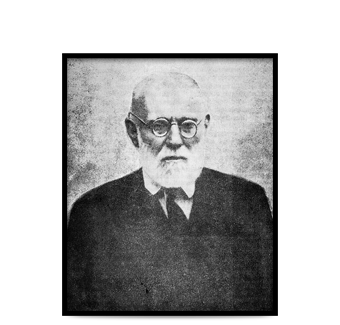
Hacking
MIT, 1959
Although the word has become inextricably linked with overly fanatic computer nerds and cybercrime, the word hacking actually means finding applications not envisaged by the maker. So using the screen of your phone as a flashlight is literally a hack. It is not only about breaking into the security systems of financial and government institutions. Hacking started at MIT when students tried to find ways to shorten and improve codes that required less punch cards. MIT still has a strong tradition when it comes to hacking they even have a Gallery of Hacks.
DONATED BY JOERI

ARPAnet
Robert William Taylor, 1969
Internet pioneer Robert William Taylor moved from NASA to the Pentagons Advanced Research Projects Agency ARPA in 1965. Taylor led the development of what has become known as the precursor of the Internet. Out of ARPA came ARPAnet which was launched on October 29 1969. High technology company. Bolt Beranek and Newman helped build it. Still with us? What a surprise. In those days computers were extremely expensive so connecting was much more cost efficient. In case you normally only read the back of food packages: Grandfather to the Internet ARPAnet Taylor 1969. Next piece please.

Ray Tomlinson, 1972
Computer engineer Ray Tomlinson worked for Bolt Beranek and Newman (BBN) as an ARPAnet contractor. ARPAnet – the forerunner of today’s Internet – made a large contribution to the development of electronic mail. Though e-mail is actually much older than ARPAnet, Tomlinson is credited for implementing the first Internet based e-mail system in 1971. He picked the @ sign to denote sending messages from one computer to another, which has been used in e-mail addresses ever since. Statistics in 2010 estimated the number of e-mails sent per day to be around 294 billion.

MUD1
Roy Trubshaw, Richard Bartle, 1978
Computer engineer Ray Tomlinson worked for Bolt Beranek and Newman (BBN) as an ARPAnet contractor. ARPAnet – the forerunner of today’s Internet – made a large contribution to the development of electronic mail. Though e-mail is actually much older than ARPAnet, Tomlinson is credited for implementing the first Internet based e-mail system in 1971. He picked the @ sign to denote sending messages from one computer to another, which has been used in e-mail addresses ever since. Statistics in 2010 estimated the number of e-mails sent per day to be around 294 billion.
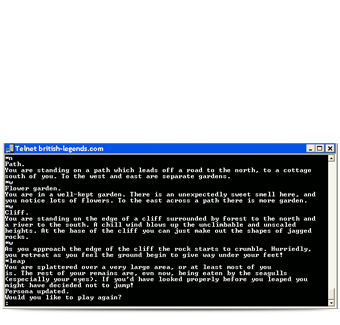
SPAM
Gary Thuerk, 1978
The earliest documented spam went out on May 1978: an ad sent to 393 people on ARPAnet, the military computer network that preceded the Internet. Gary Thuerk, a marketer for the DEC blasted out his message to sell a new line of computers. E-mail spam was born. A decade later MAKE.MONEY.FAST. was one of the most persistent chain letters in existence. The original e-mail is attributed to “Dave Rhodes”, who may or may not have existed. Today, roughly 130 billion spam e-mails are sent worldwide each day. *Cough – that’s one big pile of shit e-mail.

Usenet
Tom Truscott, Jim Ellis, 1979
Long before the World Wide Web was launched, Usenet was already connecting computers around the world. Two students, Tom Truscott and Jim Ellis, came up with the idea of a network discussion system in 1979. It allowed users to read and post messages to one or more newsgroups. Usenet looked like a hybrid form of e-mail and Web forums. Nowadays, Usenet is considered to be the precursor of today’s Web forums. And if you want to find out what people were discussing in those days, just ask Google; they host an archive of Usenet posts dating back to May 1981.

Emoticons
Scott Elliot Fahlman, 1982
How can people distinguish serious posts from jokes? Computer scientist Scott Fahlman thought of this problem and is credited for using the first emoticon online in 1982. The word ‘emoticon’ is a portmanteau word of ‘emotion’ and ‘icon’. A portmanteau, in case you didn’t know, is a combination of two words into a new word ;-). Though Fahlman may have been the first to use it online, he was not the first ever emoticon user. A similar marker appeared in Reader’s Digest in 1967. Also, Abraham Lincoln used an emoticon in his speech in 1862. People are still debating whether this was just a typographical error.
aol
William von Meister, Jim Kimsey, Steve Case, 1983
In the 1980s America Online (AOL) was a small company that provided an online service for the Commodore-64 home computer. It also had plans for video-on-demand and an online music store. AOL was somewhat ahead of its time. Just before it went bankrupt, AOL started focusing its business on BBS, the pre-Internet Internet. AOL introduced an instant messaging service in 1989 that welcomed users with the popular phrase: “You’ve got mail!” In 1991 it helped the first Internet users go online with AOL software. At its peak, AOL had 30 million users worldwide and helped shape the Internet.

Keyboard Cat
Charlie Schmidt, Fatso the Cat, 1984
Keyboard Cat is an Internet meme starring Charlie Schmidt’s cat, Fatso. It was Schmidt who manipulated his cat in such a way that leads viewers to believe Fatso is playing a nice upbeat tempo on a keyboard. The video was taped back in 1984 and Schmidt put it on YouTube in June 2007. He named it charlie schmidt’s cool cats. Later he changed the title to Charlie Schmidt’s Keyboard Cat (THE ORIGINAL). Keyboard Cat was further popularized by Brad O’Farrell, Stephen Colbert and many others. People love seeing Fatso play on his little keyboard. It was ranked #2 on Current TV’s ‘50 Greatest Viral Videos’ list.

.gif
Steve Wilhite, 1987
GIF is short for Graphics Interchange Format. From a technical standpoint, the huge success of .gif (since its introduction in 1987) is a bit of a mystery. It only supports 256 colors; its compression is inefficient; it doesn’t support sound; the last specification was published more than twenty years ago. Yet it’s still thriving. The reason, of course, is convenience. On the Web, the GIF, and especially the animated GIF, is the only video format that runs everywhere, runs automatically, and loops.

IRC
Jarkko Oikarinen, 1988
In August 1988 21-year-old Jarkko Oikarinen used his tech talents to create a chat program called IRC, or Internet Relay Chat. It was invented to support bulletin boards and discuss computer-related topics. But the first IRC users also enjoyed the social aspects of IRC chat and used it for personal stuff, sharing files and dating. However, IRC proved to be more than just a chat room and Trekkie dating service. During the Soviet coup and the Gulf War in 1991 it became the sole source of news for many users. Since that time, IRC has expanded to include several thousand networks and millions of chatters worldwide.

Chat lingo
Collective idea, 1988
Btw, gr8 pic frm ur gf on msn, tlk 2 u l8r m8 lol. If you didn’t get that last sentence, then you probably never chatted online. With the rise of the Internet, online communications like texting, online chatting, instant messaging, e-mail, blogs, and newsgroup postings are flooded with these abbreviations. They make up a new jargon known as text-message shorthand. The reason a writer uses chat lingo, of course, is to save time. However, sometimes it takes the reader a lot longer to decipher it.

HTML
Tim Berners-Lee, 1990
HTML stands for Hyper Text Markup Language and was invented by Tim Berners-Lee (a hero!) in 1990. This markup language is used to define the structure and layout of a Web page. In March 1989 CERN physicist Tim Berners-Lee wrote a paper in which he describes a way for researchers to share and collaborate with information on the World Wide Web. This paper, entitled “Information Management: A Proposal”, is now considered to be the foundation of the World Wide Web. How smart is that?
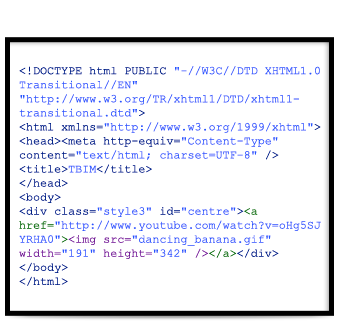
Trojan Room Coffee Pot
Computer Lab University of Cambridge, 1991
In 1991 the first webcam was created and in this first appearance, it was not pointed at the Swedish Bikini Team but at a regular coffee pot. The Trojan Room Coffee Pot is the world’s first webcam prototype, installed at the University of Cambridge and located in the “Trojan Room” within the university’s computer lab. The camera was set up because computer scientists wanted to monitor the amount of coffee left in the pot. The webcam was implemented to save pointless trips to the coffee room by providing 128×128 grayscale images of the coffee pot in real time. The pot cam even got a mention on the BBC’s longest running radio soap opera – the Archers.

Webcam
n/a, 1991
The popular use of video cameras on the World Wide Web gave the webcam its name. The first images ever taken by a webcam were of a coffee pot at Cambridge University in 1991. The footage can still be seen on its home page. Funny fact: the coffee pot is spoofed in the video game Hitman 2. The oldest webcam still in operation is FogCam at San Francisco University, which has been filming San Francisco’s famous fog (or lack of it) continuously since 1994.

Smartphone
n/a, 1992
In a way the evolution of the smartphone started when Psion introduced the first organizer in 1984. These organizers started evolving into Personal Digital Assistants (PDAs). Ah, memories. When you take a closer look at the more recent PDAs and smartphones, there isn’t that much difference. In 1992 IBM showcased the IBM Simon, the world’s first smartphone that was presented as a concept device. The first phone by Apple was ready to be launched in 2004, but the company cancelled the release. As Steve Wozniak put it: “It was not as mind-blowing as we wanted our products to be.”

Banners
n/a, 1993
When Bruce Banner gets annoyed, he changes into the Hulk. A Web banner is the complete opposite: it is annoying and changes people into sheep. Having said that, we must admit that the Internet would not be the same if it weren’t for banners. The first clickable Web ad was created in 1993 for a law firm. From that moment on, advertising banners made huge amounts of money for Web site owners. Every click on a banner usually generates about 5 to 10 cents. So now you know who pays for all that content you stare at every day. Except for this Web site; we are funded by love and pizza.

Netscape
Jim Clarke, Marc Andreessen, 1994
Netscape was founded in 1994 by Jim Clarke with co-founder Marc Andreessen under the name Mosaic Communications Corporation. Andreessen had just graduated from university, where he had been the leader of a software project called “Mosaic”. Sounds familiar? The Web browser Mosaic Netscape 0.9 was the company’s first product and they renamed it later to Netscape Navigator. Netscape advertised that ‘the Net is for everyone’. We totally agree.

Lycos
Michael Loren Mauldin, 1994
University campuses are fertile grounds for Internet successes. Just like Facebook, search engine and Web portal Lycos was born in a university as a research project, devised by Michael Loren Mauldin. Conceived in the mid-90s, Lycos went through all the different phases of the turbulent Internet era. Hence the explosive growth after its launch, the huge take-over near the peak of the Internet bubble ($12 billion), and the more difficult times that inevitably came after the bubble burst. In 2010 Lycos was sold for $36 million to Internet marketing company Ybrant Digital.

Smart TV
n/a, 1994
‘Smart’ is the latest buzzword in technology these days: smartphone, smart charging, smart fridge, smart TV and, hopefully, smart clothes. Smart TVs integrate the Internet and Web 2.0 features into television sets and set-top boxes. As technology advances, smart TVs with their own operating systems will become as functional as computers. We reckon the next logical step will be adding even smarter features, such as voice-controlled full immersive virtual reality systems with 3D sound. We can’t wait to plug into heaven so just give us a headset.

MSN
Microsoft, 1995
Windows Live Messenger (formerly MSN Messenger) originated back in the days that anything Microsoft touched turned to gold. It started off as a very small experiment in 1995. MSN – or The Microsoft Network – was ‘only’ a tiny online service introduced at the launch of Windows 95. Thanks to its simple user interface (a text box with a few smilies and a video calling functionality) the instant messaging client became extremely popular. In 2012 Microsoft announced that it intends to retire MSN and replace it with Skype.

GeoCities
David Bohnett, John Rezner, 1995
GeoCities was once a very popular Web-hosting service that was established in 1995. Founded by John Rezner and David Bohnett in 1994, it was originally known as the Beverly Hills Internet (BHI). Yahoo! purchased it in 1999, and by that time GeoCities was the third-most visited Web site on the Web. At first, people could select a city in which to place their Web site. For example, a site about entertainment was assigned to Hollywood. And a Web site about the world’s most gorgeous models was situated in Amsterdam. However, that might not actually be true. Although Yahoo! closed down GeoCities in 2009, users can still access some of the sites.

Open dir
n/a, 1995
Discovering an open dir was like finding a wallet on the street: it piqued your curiosity and there was always a reward inside. Most of the time an open dir was a temporary version of a Web site that was down for maintenance. Instead of a work-in-progress announcement, a simple structure of folders displayed the content of the Web site. You could access any folder and easily download content. Particularly open directories with porn or music attracted a lot of attention. And if you couldn’t find an open dir, there were always dedicated blogs that published lists of open dir Web sites.
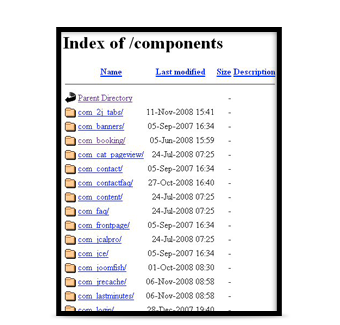
AltaVista
Paul Flaherty, Louis Monier, Michael Burrows, Joella Paquette, 1995
AltaVista was once one of the most popular web search engines and was owned by Yahoo! It was developed by researchers at DEC’s Network Systems Laboratory and Western Research Laboratory. The name literally means ‘a view from above’ and was chosen to reflect the surroundings of their company at Palo Alto (US). AltaVista was launched on December 15, 1995, at altavista.digital.com and was an immediate success. The search engine received 300,000 hits on the first day and more than 80 million hits a day two years later.

ICQ
Yair Goldfinger, Arik Vardi, Sefi Vigiser, Amnon Amir, 1996
ICQ was the first free Internet-wide instant messaging service. Yair Goldfinger, Arik Vardi, Sefi Vigiser and Amnon Amir, four young programmers at the Israeli company Mirabilis wrote the program in less than two months without a budget. The first version was released in November 1996 and it soon revolutionized communication. Later ICQ became the basis for most instant messaging platforms. America Online (AOL) bought ICQ for $407 million in 1998. ICQ, shorthand for ‘I seek you’, is also an adaptation of the Morse code “CQ call”, which stands for ‘calling any station’.
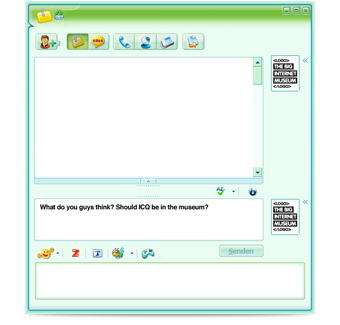
Flash
Jonathan Gay, 1996
Adobe Flash (an abbreviation of its predecessor’s name, FutureSplash) provides animation of text, drawings and still images, and also supports streaming audio and video. Some say it enriches their Web experience, while others find the extensive use of it, particularly in advertising, intrusive and annoying. Flash also made the transition to the big screen. The Secret of Kells, an Irish film, was animated primarily in Flash, and was nominated for an Academy Award for Best Animated Feature.

Jennicam
Jennifer Ringley, 1996
In 1996 JenniCAM was the most talked-about site on the Internet. Twenty-year-old student Jennifer Ringley started her own personal webcam site. It all began as an “experiment”; Jennifer set up a camera, linked it to her computer in her college dorm room and broadcast her life over the Web, 24 hours a day, 7 days a week – live and, yes, uncensored. It attracted a huge amount of visitors. At one point she would get around 100 million hits a week. As one journalist put it: She was the inventor of reality television.

56k Modem
Brent Townshend, 1996
Canadian inventor Dr Brent Townshend created a core concept in 1996 that served as the basis for the 56k modem. This voiceband modem is nominally capable of download speeds of up to 56,000 bits per second. Initially there were two rival modem systems: K56flex and X2. In the late 1990s, 56k modems were the most popular access method for personal Internet usage. We just loved their hissing and beeping sounds. The sounds weren’t a sign that data were being transferred: they were the actual data being transferred. The world was shifting from analog to digital and you could hear it.

WAP
WAP Forum, 1997
Wireless Application Protocol, or WAP for short, was a popular type of mobile Internet access created in 1997. It is the result of a joint effort by companies teaming up in a group called WAP Forum. WAP could be used for Internet access, e-mail, instant messaging and more on mobile phones and other wireless devices. Nowadays WAP is, excusez-moi, dead. It has gone to meet its makers.
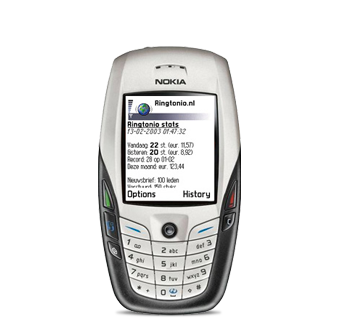
WI-FI
VIC HAYES, JOHN O’SULLIVAN, 1997
Wi-Fi, or 802.11 networks, is a technology that allows a device to exchange data using radio waves, just like cellphones and radio’s do. A Wi-Fi network – short for Wireless Fidelity – is relatively cheap and easy to set up. Devices that use Wi-Fi can connect to a network via a wireless network access point, also called “hot spots”. One of the key technologies behind Wi-Fi was developed by radio astronomer John O’Sullivan as a by-product in a research project to detect mini black-holes. That sounds rather cool, doesn’t it? Vic Hayes has been called the “father of Wi-Fi”, he chaired the IEEE committee that created the 802.11 network in 1997.
DONATED BY STEVE

Larry Page, Sergey Brin, 1997
PhD students Larry Page and Sergey Brin originally set up Google as a research program at Stanford University. They first met in March 1995 during spring orientation of new PhD candidates. Later they began collaborating on a search engine called BackRub. In 1997 Page and Brin gave the search engine a new name: Google. It was chosen for its resemblance to the word googol, a 1 followed by 100 zeros. Paying attention in the back? Today, Google Inc. is a multinational built around a mindboggling, huge search engine that includes cloud computing, software and advertising technologies.

Blogging
Jorn Barger, Peter Merholz, 1997
After the invention of the HTTP protocol people started posting online diaries, chronicling their thoughts and day-to-day lives. Not long afterwards personal logs started to spread all over the Internet. Jorn Barger came up with the term “Web log” on December 17, 1997. Two years later Peter Merholz wrote the word “blog” as a joke on his Web log. Later, tiny personal blogs known as microblogs became extremely popular – the most popular being Twitter, of course. Most of the time blogging is free, with services like Blogger or WordPress. It’s fun, fast and blogging can have a huge impact, even on governments.

Napster
Shawn Fanning, John Fanning, Sean Parker, 1998
Napster has often been called the fastest-growing business in history. It was co-founded in 1998 by Shawn Fanning, his nephew John Fanning and Sean Parker as an independent peer-to-peer file-sharing service. Napster was named after Shawn Fanning’s nickname, which he got for his nappy hair under his baseball cap. Within a year the service had ten million users. Napster allowed them to easily share MP3 files with each other. In 1999 the company was sued by metal band Metallica for copyright violations. But because of the huge publicity, Napster grew even bigger. In 2011 Rhapsody acquired Napster and restructured it completely.

AYBABTU
Taoplan, 1998
“All your base are belong to us” comes from the opening scene in the Sega Mega Drive version of the 16-bit video game Zero Wing. The phrase was an awkward translation from the original Japanese version. It became a very popular catchphrase that swept across the Internet, but its first appearance is hard to trace due to Web sites closing down. The “All your base” phrase and the dialogue scene went viral on forums in 2000. The introduction sequence of the video game contained many more hilarious broken English phrases (Engrish) like “You know what you doing” and “Somebody set up us the bomb”.
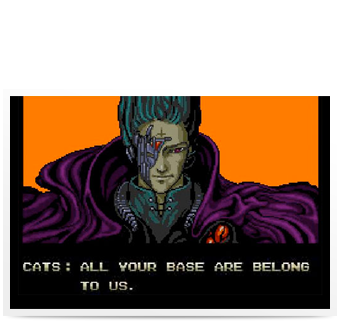
i-mode
Mari Matsunaga, Takeshi Natsuno, Keiichi Enoki, 1999
This mobile Internet service is especially popular in Japan. i-mode was launched in 1999 by Japan’s leader in wireless technology: NTT DOCOMO. The content planning and service design was led by Mari Matsunaga, while Takeshi Natsuno was responsible for the business development. Keiichi Enoki oversaw the technical and overall development (stay with us and read on). Just like WAP, it uses a packet switching system to transfer data from one terminal to another. i-mode is very common in Japan, but in all the places around the world where the technology was introduced, it was phased out again due to a lack of interest.

LimeWire
Mark Howard Gorton, 2000
LimeWire is a free open-source program for downloading and sharing files through a p2p network. You probably used it a zillion times before a US federal court issued an injunction forcing LimeWire to prevent “the searching, downloading, uploading, file trading and/or file distribution functionality, and/or all functionality” of its software. With that, the judges successfully put an end to the downloading of illegal files on the Internet. Eh, hold a second…

CAPTCHA
Luis von Ahn, Manuel Blum, Nicholas Hopper, John Langford, 2000
Despite what some people think, a CAPTCHA is not intended to prevent hackers from cracking a Web site. It is a program that protects Web sites against automated bots. Humans can pass a CAPTCHA test, but current computers are unable to read the distorted text. The acronym CAPTCHA stands for Completely Automated Public Turing test to tell Computers and Humans Apart. In the future computers may be smart enough to pass the Turing test. That way CAPTCHAs won’t outsmart them anymore. And when that happens…….run!

PBJT
Ryan Gancenia Etrata, Kevin Flynn, 2000
This dancing banana became a hit in the early 2000s. It’s an animated dancing banana character combined with the song Peanut Butter Jelly Time by the Buckwheat Boyz and is known for being both obnoxious and hilarious. The original Flash animation was created by Ryan Gancenia Etrata and Kevin Flynn, who posted it on forums in 2002. The meme was even referred to in an episode of the animated television series Family Guy. Brian Griffin, the anthropomorphic dog, dances and sings the song in a banana outfit. We just love that.

Wikipedia
Jimmy Wales, Larry Sanger, 2001
In 2001 Jimmy Wales and Larry Sanger launched Wikipedia: a free online encyclopedia. What is unique about Wikipedia is that all the articles are open content; anyone can edit any article at any time. Every day about 100,000 volunteers help out to correct the spelling and grammar, check facts and sources, lay out articles and report vandalism and other fraudulent behavior. Wikipedia has collected more than 4,000,000 articles in English and over 19,000,000 more in over 285 languages. If the total content of Wikipedia were to be published in book form, you would need a bookshelf that can hold 5,542 volumes.

Friendster
Jonathan Abrams, 2002
Founded in 2002 by Jonathan Abrams in Mountain View, California. *Ahem, it’s always in California, isn’t it? The bold idea behind Friendster was to create a safer, more effective environment for meeting new people and friends. Within a few months Friendster was rapidly adopted by three million users. At first it was a social networking Web site – it is even considered the “grandaddy” of all social networks as well as the very first online social network. In June 2011 the company repositioned itself to become a social gaming site.

Entropia Universe
Mindark, 2003
In 2003 Swedish software company MindArk launched Entropia Universe: a MMORPG with a planetary system and a real cash economy. Entropia Universe entered the Guinness World Records book in both 2004 and 2008 for the most expensive virtual world objects ever sold. It reached another milestone in 2010 when a virtual resort on Planet Calypso was sold for $635,000. Real dollars, that is. And just when the developers thought it couldn’t possibly get any better, the Entropia Universe reached yet another major milestone: a place in the Big Internet Museum.

Skype
Ahti Heinla, Priit Kasesalu, Jaan Tallinn, 2003
Skype is a ‘Voice over Internet Protocol’ (VoIP) service and software application. It sounds complicated, but it’s not; it all comes down to you, a headset, a webcam, a computer, the Internet, stuff to talk about and, of course, someone to talk to. Skype allows you to send messages, share files and make phone calls with or without video. Free of charge! For the first time people can communicate like they do in science-fiction movies. Or as some have described Skype: it’s like chatting with sound.

Myspace
Tom Anderson, Intermix Media, 2003
Until 2001 the domain myspace.com was actually a place to upload and download large files. In 2003 the domain was picked up by Tom Anderson at Intermix Media. The Web site is a social network, based on music. It meant a breakthrough for quite a lot of singers and bands including The Devil Wears Prada, Lily Allen and Kate Nash. In July 2005 Intermix Media sold the Web site to Rupert Murdoch’s News Corporation for a stunning $580 million. Numbers began to drop and in 2011 Specific Media bought the Web site for $35 million. Justin Timberlake is one of the new owners who have big plans for the site. We are holding our breath to see if they can restore it to its former glory.

4chan
Christopher Poole, 2003
4chan was founded in 2003 by Christopher Poole and is a vastly popular image board. At that time Poole (known on the Web site as “moot”) was just fifteen years old. He intended 4chan to be a place to discuss Japanese comics, graphic novels and anime. At first glance 4chan could be mistaken for a simple bulletin board, but it is now linked to Internet activism and subcultures. The Web site proved the power to the people and its users are responsible for a large number of popular Internet memes. Nowadays 4chan.org is one of the most visited Web sites on the Internet.

Star Wars Kid
Ghyslain Raza, 2003
In 2002, 15-year-old Ghyslain Raza taped himself mimicking Darth Maul from Star Wars I: The Phantom Menace. The tape was never erased and students soon found out about it. The tape became one of the very first Internet memes; The Star Wars Kid spawned many spoofs and parodies on the Web. And although Ghyslain became very popular and many viewers found him endearing – there even was a petition to get him a role in a Star Wars movie – Ghyslain’s saga was not a very pretty one. He endured a lot of harassment from fellow students and dropped out of school. The Star Wars Kid meme became a prime example of cyber bullying.

Second Life
Philip Rosedale, 2003
There’s a place where you can find yourself chitchatting with a fancy lady on a steep cliff overlooking the sea. It’s called Second Life and, in some way, this virtual world is a big daydream. And a realistic dream too with gravity, housing, its own economy and currency: the Linden dollar. Second Life was launched on June 23, 2003, by Philip Rosedale and Linden Lab. In 2005 and 2006 Second Life began building a lot of media traction and large companies were almost desperate to become a part of this 3D world. However, things got a bit quiet around Second Life; it nevertheless managed to register 21.3 million accounts in 2010.

Numa Numa guy
Gary Brolsma, 2004
In December 2004 18-year-old Gary Brolsma uploaded a quirky video of himself mimicking the song Dragostea din tei of Moldavian pop group O-Zone. Gary became an overnight Internet phenomenon and was nicknamed the Numa Numa guy. By June 2012 the video called Numa Numa Song had been watched over 700 million times. Since its release, Numa Numa Song has spawned many parody videos, TV series and even music videos of famous artists. You can still see the song on YouTube, but be warned: it will stick in your head forever.

World of Warcraft
Blizzard Entertainment, 2004
World of Warcraft (or WoW) is the fourth release in the Warcraft game series set in the Warcraft universe. The first one was Warcraft: Orcs and Humans which was released in 1994. Announcing the game in September 2001, the game was released on November 23, 2004: the tenth anniversary of the franchise. At this moment the world of Azeroth has an astounding ten million subscribers, peaking at twelve million in 2010, and is officially the most popular MMORPG – it even holds a Guinness World Record. Of course, a game this big has had its own episode on South Park and has its own wiki.

Mark Zuckerberg, Eduardo Saverin, Andrew McCollum, Dustin Moskovitz, Chris Hughes, Sean Parker, 2004
Facebook is a social network that was launched in 2004. Initially it served as a network for Harvard University students. Eventually Facebook became available, with a few exceptions, to the rest of the world. So unless you are living in Iran or China, you can use Facebook to upload photos, state your status and respond to other people’s posts or simply ‘Like’ them. These four ingredients are the basis of this highly-addictive social platform where you can follow your friends, colleagues, family and other acquaintances. The more the merrier. In theory, you could have 1 billion people be your friend.

Google Maps
Lars Rasmussen, Jens Rasmussen, 2004
If you’re lost almost anywhere on the planet you’ll certainly find your way back with Google Maps. This Google service offers mapping technology and local business information. It first started as a C++ program designed by two Danish brothers Lars and Jens Rasmussen at the Sydney-based company “Where 2 technologies”. In 2004 the company was acquired by Google Inc. Google Maps was first announced on the Google Blog on February 25, 2005. There’s even a Google Moon and Mars, with imagery of the Moon and the planet Mars. Could come in handy one day.

Bebo
Michael Birch, Xochi Birch, 2005
Thanks to the Internet we know how to build a four-mast vessel from scratch, and anyone can connect to anyone. Launched in 2005, Bebo became one of the most popular social networking sites, connecting millions of subscribers with each other. Michael Birch and his wife Xochi Birch founded Bebo at their home in San Francisco. Users receive a personal profile page – which is private by default – where they can post blogs, pictures, videos, music, and so on. AOL bought Bebo in 2008 for $850 million. Surely they celebrated with an oversized bottle of champagne at the Birch residence, wouldn’t you agree?

Megaupload
Kim Dotcom, 2005
Megaupload was an online company established in 2005 and one of the largest file-sharing sites on the Web. The Hong-Kong based download mecca allowed users to upload anything from a text file to a full feature film, and then share links to the file with others. The United States Department of Justice shut Megaupload down on 19 January 2012. The company’s founder ‘Kim Dotcom’ – born Kim Schmitz – was arrested but denied any wrongdoing. Though Mr. Dotcom was accused of Internet piracy, his lawyers stated that his company simply offered online storage, and that their client is innocent. One year after being arrested Kim launched a new online cyberlocker where each user gets 50GB of free storage. Smartass.

CHUCK NORRIS
Conan O’Brien, 2005
Chuck Norris is an American actor and a martial arts expert. Yep, he’s tough. In early 2005, Norris became the object of an ironic Internet meme known as “Chuck Norris Facts”. Chuck Norris jokes appeared all over the Internet and it set him up as the ultimate hero proclaiming his legendary toughness. Talk show host Conan O’Brien’s Chuck Norris jokes were seen as an inspiration for the meme. Norris stated that he does not feel offended by them and finds some of them funny. And some are indeed hilarious, like this fact: Norris is bitten by a cobra and, after five agonizing days, the cobra dies.

LOLcats
Collective idea, 2005
Actually, the first person to make funny pictures of cats with a humorous caption was photographer Harry Pointer in the 1870s. As stated in Maslow’s Hierarchy of Internet Needs, “above all else users require funny pictures of cats” – even more than social networks, porn and fails. This is the insight LOLcats.com, a Web site full of funny pictures of cats with humorous captions, was built on. The text, by the way, is in a slang called “lolspeak” or “kitty pidgin” and is grammatically totally incorrect. LOLcats are posted on all sorts of blogs and forums, such as icanhas.cheezburger.com.

Youtube
Chad Hurley, Steve Chen, Jawed Karim, 2005
If you have never heard of YouTube, you either live under a rock or you simply hate videos. The video-sharing Web site was created by three former PayPal employees in 2005. Chad Hurley, Steve Chen and Jawed Karim invented YouTube out of a garage in Menlo Park, California. It caught on almost immediately. In 2006 there were 100 million videos in YouTube’s searchable archive. YouTube is still immensely popular and most of the content is uploaded by individuals. Me at the zoo was the first video on YouTube and shows co-founder Jawed Karim at the San Diego Zoo.

Leeroy Jenkins
Guild PALS FOR LIFE, Ben Schulz, 2005
Leeroy Jenkins is a meme that started in 2005 with the release of a video clip by the PALS FOR LIFE player guild on the World of Warcraft game forum. Leeroy Jenkins is the name of a WoW player character created by Ben Schulz. In the video we hear someone shout “Leeroy Jenkins!” While the players are discussing a battle strategy, Leeroy moves away from his computer and moments later all the players get killed. Blizzard, the company behind WoW, eventually paid tribute to Leeroy by creating an achievement called “Leeeeeeeeeeeeeroy!” in the game itself. The Internet meme was immensely popular and also spread to other media, including movies and TV shows.

Jack Dorsey, 2006
Jack Dorsey created social-networking/microblogging service Twitter. Entry-character limit is 140, which makes this a characteristic #tweet.

Rickroll
Collective idea, 2007
Rickrolling is a 2008 Internet meme, and is a bait-and-switch. With a Rickroll you trick someone to watch a music video – Rick Astley’s hit single Never Gonna Give You Up – by claiming that it is something far more interesting. A person provides a hyperlink seemingly relevant to the topic at hand, but this link actually leads to Rick Astley’s video clip. It is said that the Internet meme helped revive Astley’s career.

Elf Yourself
Jason Zada, 2006
It’s simple: upload a picture of yourself, select an area and hit Submit. A moment later you see a dancing elf with your face on it. Works like a charm. The Elf Yourself interactive Web site and advertising campaign were launched in 2006 and have returned every season. OfficeMax contacted the New York company Toy to create multiple Web sites for their holiday campaign. Toy contacted Jason Zada and he then developed the Elf Yourself application. It was an instant hit: in 2006, the holiday-themed website received over 36 million visits in five weeks and 11 million elves were created.

Chatroulette
Andrey Ternovsky, 2009
Andrey Ternovsky created Chatroulette when he was 17 and the name is obviously based on the slightly dangerous game of Russian roulette. It’s an online chat service that pairs strangers from around the world to chat to each other via webcams. Don’t like the person you are talking to? Just press ‘Next’ and on you go. The site has seen an explosive growth of users; in 2010 it had as many as 35,000 users online at any given moment. The controversial Web site received an enormous amount of media coverage when it was reported that: ‘Chatroulette is 89% male, 47% American and 13% perverts’.

KEVIN SYSTROM, MICHEL “MIKE” KRIEGER, 2010
Simply put, Instagram is a free photo app and a social network. It was the brainchild of Kevin Systrom and Michel “Mike” Krieger; when it was launched in October 2010, very few people noticed. Pictures taken by the app look like they have had a cool vintage filter applied to it. On Instagram, you can also follow other users’ photo streams. In 2012 Facebook acquired the photo-sharing program for approximately $1 billion. At the time Instagram only had 13 employees.

Double rainbow
Hungrybear9562 (Paul Vasquez), 2010
Paul “Bear” Vasquez, aka Hungrybear9562, posted this homemade video filmed in his front yard on YouTube on January 8, 2010. It sat there for months until late-night talk show host Jimmy Kimmel discovered it on July 3 and tweeted a link to the video. About an hour later, sports columnist Bill Simmons retweeted it. After that the video went viral and received more than 35 million views. So what does a double rainbow mean? Our guess is: we’ll never know.

MINECRAFT
MARKUS ALEXEJ “NOTCH” PERSSON, 2011
Minecraft is an indie video game hit created by Markus Alexej (“Notch”) Persson officially released by Mojang on November 17, 2011. It’s an open-world adventure and building game: whatever you put your mind to, you can design and create it. In a way, Minecraft is the exact opposite of most games. It’s all about creating and destroying various types of blocks in a three-dimensional environment, instead of accomplishing something. This sandbox game is characterized by its stylized pixel artwork. However, looks aren’t everything. It’s the idea that really matters. My mother told me that.

Nyan cat
Christopher Torres, Saraj00n, 2011
Nyan Cat is an 8-bit animation combining a cat, a cherry Pop Tart and the song Nyanyanyanyanyanyanya. Originally the cat was named Pop Tart Cat and illustrator Christopher Torres made the original drawing. On April 5, 2011, YouTube user Saraj00n combined the cat animation with the song and posted it online. Currently the original video has had more than 85 million hits on YouTube. Why that many? Like all surrealistic comedy, Nyan Cat is something you either get or you don’t. Perhaps this is the secret behind this particular combination of a cat and a song that has captivated millions.
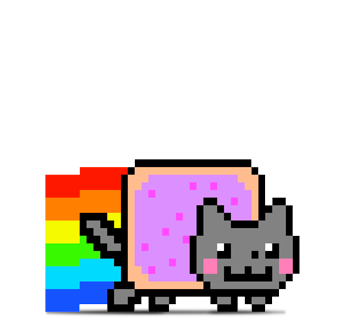
Gangnam Style
Park Jae-Sang, 2012
PSY, whose real name is Park Jae-Sang, has become a global sensation since Gangnam Style’s release on July 15, 2012. The video clip pokes fun at the consumerism of Gangnam, an upmarket neighbourhood in Seoul, South Korea. On December 21, 2012, “Gangnam Style” (Korean: 강남스타일), reached more than a billion (!) views on YouTube. We bet all the ladies try to get a lasso around this guy now. The energetic Korean musician certainly has the perfect dance moves as though he’s riding on a horse. “Gangnam Style” holds the Guinness World Record for the most “liked” song ever on YouTube.
